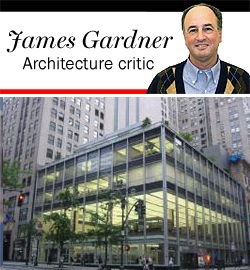Trending
City must preserve integrity of Manufacturers Hanover Trust Branch Bank
The iconic Manufacturers Hanover Trust Branch Bank at 510 Fifth Avenue, between 42nd and 43rd streets, whose fate is now in the hands of the Landmarks Preservation Commission, is a victim of its very success in two senses of the term.
Perhaps the more obvious sense is that the revolution it inaugurated in bank design proved so successful throughout the world that one almost requires an act of historical imagination to realize what things were like before it was completed in 1954 according to designs by Gordon Bunshaft and Charles Evans Hughes III of Skidmore, Owings & Merrill.
Almost from the inception of banks as a distinct architectural type in the 19th century, their overwhelming point had been to communicate a sense of fortress-like solidity and permanence. “Your money is safe here,” the ever so grown-up granite masonry seemed to proclaim. But these were the very banks that wrought such havoc during the Great Depression.
And so when the chairman of Manufacturers Hanover Trust, Horace “Hap” C. Flanigan, decided, in the early 1950s to build a new statement building in the center of Midtown, he broke from tradition with a revolutionary structure whose transparency so far transcended the brick and mortar of the past that the building almost seemed to dematerialize before your eyes. What you saw was a four-story, 60-foot tall mirage of curtain wall with no entrance (at least not on Fifth Avenue) and the thinnest mullions and infill to hold the glass in place.
Since then, this model has been replicated so often that most people who pass the building hardly glance at it. It looks like just another Midtown bank. That is the first sense in which it is a victim of its success. The second is that it continues to attract the attention of a tiny sector of the population, who value its historical importance to such a degree that they wish to see no change to its exterior or even to its interior.
And that is why there is such hostility to the plans, revealed in recent months by the present owner, Vornado Realty Trust, to transform the space, which no longer serves as a bank, into two smaller retail spaces. This would result in making an entrance on Fifth Avenue and in rotating the escalators and bringing them closer to the front of the building. Although the most recent renderings certainly make the change look surgical and minimal, it is hard to see how the interior could be transformed into two retail spaces without powerfully changing the feel of the whole structure. Especially when you consider that the sort of businesses in question will presumably resemble Hollister, Abercrombie & Fitch and Juicy Couture, slightly further north along the avenue, in the degree of their boldly idiosyncratic and branded looks.
And yet, it would go against the innovative spirit of the building, as well as against the spirit of Midtown itself, for this important space to be immobilized in the name of preserving a landmark (as it has officially be since 1997). The more so since Horace Flanigan built it back in 1954 precisely so that, if it didn’t succeed as a bank, it could be readily converted to retail.
That said, every effort must be made to preserve its structural and aesthetic integrity as much as possible. At the very least, we should lament the nature of things, which seems to dictate that this splendid monument must be inevitably diminished, even if it does not entirely pass away.





